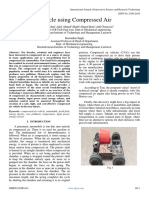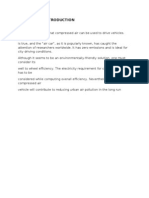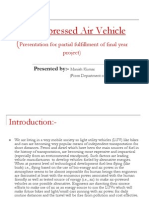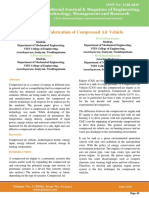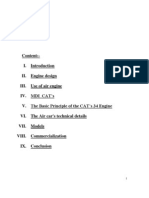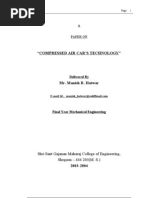Compressed Air Vehicle (Cav) (A Practical Approach With Design)
Compressed Air Vehicle (Cav) (A Practical Approach With Design)
Uploaded by
iaetsdiaetsdCopyright:
Available Formats
Compressed Air Vehicle (Cav) (A Practical Approach With Design)
Compressed Air Vehicle (Cav) (A Practical Approach With Design)
Uploaded by
iaetsdiaetsdOriginal Description:
Original Title
Copyright
Available Formats
Share this document
Did you find this document useful?
Is this content inappropriate?
Copyright:
Available Formats
Compressed Air Vehicle (Cav) (A Practical Approach With Design)
Compressed Air Vehicle (Cav) (A Practical Approach With Design)
Uploaded by
iaetsdiaetsdCopyright:
Available Formats
INTERNATIONAL JOURNAL OF MULTIDISCIPLINARY EDUCATIONAL RESEARCH
ISSN : 2277-7881; IMPACT FACTOR - 2.735; IC VALUE:5.16
VOLUME 3, ISSUE 9(2), SEPTEMBER 2014
COMPRESSED AIR VEHICLE (CAV)(A PRACTICAL
APPROACH WITH DESIGN)
Sai Chakradhar. Kommuri
Student
Department of Mechanical Engineering
QISCET, Ongole
HISTORY OF CAV:
Compressed air has been used since the 19th century to
power mine locomotives and trams in cities such as Paris (via a central,
city-level, compressed), and was previously the basis of
naval torpedo propulsion.
During the construction of the Gotthardbahn from 1872 to
1882, pneumatic locomotives were used in the construction of
the Gotthard Rail Tunnel and other tunnels of the Gotthardbahn.
In 1903, the Liquid Air Company located in London England
manufactured a number of compressed-air and liquefied-air cars. The
major problem with these cars and all compressed-air cars is the lack of
torque produced by the "engines" and the cost of compressing the air.
INTRODUCTION
Compared to batteries, compressed air is favourable because of a
high energy density, low toxicity, fast filling at low cost and long service
life. These issues make it technically challenging to design air engines
for all kind of compressed air driven vehicles. To meet the growing
demand of public transportation, sustainable with environmental
consciousness, people are in the search for the ultimate clean car with
zero-emissions. Many concept vehicles were proposed that run on
everything from solar power to algae, but most of them are expensive
213
INTERNATIONAL JOURNAL OF MULTIDISCIPLINARY EDUCATIONAL RESEARCH
ISSN : 2277-7881; IMPACT FACTOR - 2.735; IC VALUE:5.16
VOLUME 3, ISSUE 9(2), SEPTEMBER 2014
and require hard-to-find fuels .Compressed air vehicle project in the
form of light utility vehicle (LUV) (i.e., air car in particular) has been a
topic of great interest for the last decade and many theoretical and
experimental investigations.
COMPRESSED AIR TECHNOLOGY
Mankind has been making use of uncompressed airpower from
centuries in different application viz., windmills, sailing, balloon car,
hot air balloon flying and hang gliding etc. The use of compressed air
for storing energy is a method that is not only efficient and clean, but
also economical and has been used since the 19th century to power
mine locomotives, and was previously the basis of naval torpedo
propulsion. The laws of physics dictate that uncontained gases will
fill any given space. The easiest way to see this in action is to inflate
a balloon. The elastic skin of the balloon holds the air tightly inside, but
the moment you use a pin to create a hole in the balloon's surface, the
air expands outward with so much energy that the balloon explodes.
Compressing a gas into a small space is a way to store energy. When the
gas expands again, that energy is released to do work. That's the basic
principle behind what makes an air car go. The air compressors are
built into them.
The principle of compressed-air propulsion is to pressurize the
storage tank and then connect it to something very like a reciprocating
engine of the vehicle. Instead of mixing fuel with air and burning it in
the engine to drive pistons with hot expanding gases, compressed air
vehicles (CAV) use the expansion of compressed air to drive their
pistons. Thus, making the technology free from difficulties.
The air is compressed at pressure about 150 times the rate the
air is pressurized into car tyres or bicycle. The tanks must be designed
to safety standards appropriate for a pressure vessel. The storage tank
may be made of steel, aluminium, carbon fibre, Kevlar or other
214
INTERNATIONAL JOURNAL OF MULTIDISCIPLINARY EDUCATIONAL RESEARCH
ISSN : 2277-7881; IMPACT FACTOR - 2.735; IC VALUE:5.16
VOLUME 3, ISSUE 9(2), SEPTEMBER 2014
materials, or combinations of the above. The fibre materials are
considerably lighter than metals but generally more expensive. Metal
tanks can withstand a large number of pressure cycles, but must be
checked for corrosion periodically. A company has stated to store air in
tanks at 4,500 pounds per square inch (about 30 MPa) and hold nearly
3,200 cubic feet (around 90 cubic metres) of air. The tanks may be
refilled at a service station equipped with heat exchangers, or in a few
hours at home or in parking lots, plugging the vehicle into an on-board
compressor. The cost of driving such a car is typically projected to be
around Rs. 60 per 100 km, with a complete refill at the "tank-station" at
about Rs. 120 only.
The compression, storage and release of the air together
are termed as the Compressed Air Technology. This technology
has been utilized in different pneumatic systems. This technology has
been undergoing several years of research to improve its applications.
WORKING
The air-powered car runs on a pneumatic motor that is powered
by compressed air stored on board of the vehicle. Once compressed air
is transferred into the on board storage tank, it is slowly released to
power the cars pistons The engine that is installed on the compressed
air car, uses compressed air which is stored in the cars tank. The
compressed air drives the piston down as the power stroke. At the end
of the power stroke, the compressed air is released through the exhaust
valves and the exhaust is only air. The motor then converts the air
power into mechanical power. That power is then transferred to the
wheels and becomes the source of power for the car. ( i.e. the pistons
were connected to the wheels through the HERO HONDA bikes 4
speed transmission.). This modified engine was mounted on a
rectangular crossectional frame and a body that looked like a curious
crossbreed of a car.
215
INTERNATIONAL JOURNAL OF MULTIDISCIPLINARY EDUCATIONAL RESEARCH
ISSN : 2277-7881; IMPACT FACTOR - 2.735; IC VALUE:5.16
VOLUME 3, ISSUE 9(2), SEPTEMBER 2014
PROPERTIES OF AIR CAR ENGINE
The properties of air car engine are:
1. Approximately 0.05 mt3 of compressed air is stored in mild steel
tank in the vehicle.
2. The engine is powered by compressed air, stored in the tank at
30bar. In order to reduce weight, the tank can be made of
carbon fibre.
3. The expansion of this air pushes the piston and creates
movement. The atmospheric temperature is used to reheat the
engine and increase the road coverage.
4. The air condition system can be made use of the expelled cold
air.
We only need a simple piston-cylinder arrangement with an intlet
and an exhaust. But as we know a normal two stroke engine contained
several ports and it also had the spark plug which we didnt require. So,
due to the presence of ports in a two stroke engine, it is difficult to get
required output from the engine. So, several modifications had to be
done on the four stroke engine to suit our purpose.
The modifications comprised of: Providing a suitable connector at the cylinder head.
216
INTERNATIONAL JOURNAL OF MULTIDISCIPLINARY EDUCATIONAL RESEARCH
ISSN : 2277-7881; IMPACT FACTOR - 2.735; IC VALUE:5.16
VOLUME 3, ISSUE 9(2), SEPTEMBER 2014
Removing the spark plug from the cylinder head.
Modifying the cam shaft of the engine.
1. COMPRESSED AIR TANK
Compressed air tank is one of the most important part of these
cars. These tanks hold 0.05m3 of air to 30 bars. It is similar to the
tanks used to carry the liquid gas. The tank enjoys the same technology
developed to containing natural gas. These tanks do not explode in case
of accidents since there are no metals in them if made of carbon fibre.
So the selection of material for the storage tank matters much
in safety.
2. ENGINE SPECIFICATIONS
Made: HERO HONDA
Model: CD100
Stroke: 4 stroke
No. of cylinders: Single cylinder
Displacement: 110 cc
3. THE CHASSIS
Based on design principles in aeronautics, engine has put
together highly-resistant, yet light, chassis, zinc rods welded together.
Using these rods enables us to build a more shock-resistant
chassis than regular chassis, allowing quick assembly and a more
secure. This system helps to reduce manufacture time.
4. AIR FILTER
The engine works with air taken from the atmosphere. Air is
compressed by the off-board compressor or at service stations equipped
with a high-pressure compressor. Before compression, the air must be
filtered to get rid of any impurities that could damage the
engine. Carbon filters are used to eliminate dirt, dust, humidity and
other particles which, unfortunately, are found in the air in our cities.
217
INTERNATIONAL JOURNAL OF MULTIDISCIPLINARY EDUCATIONAL RESEARCH
ISSN : 2277-7881; IMPACT FACTOR - 2.735; IC VALUE:5.16
VOLUME 3, ISSUE 9(2), SEPTEMBER 2014
5. REFILLING
As these energies are so easy to store Filling stations are
setup as for petrol and diesel. The filling of tank of an air car nearly
takes 3 to 4 minutes for cars. Either, we can set up a filling equipment
too in our house, which is quite cheaper.
6. SPECIAL FEATURES
There is absolutely no fuel required and no combustion in the
engine cylinder.
There is no pollution at all as only air is taken in and air is ejected
out.
No Heat is generated, as there is no combustion.
No engine cooling system is required, like water Pump, radiator,
and water Circulating pipes. It was measured practically that the
engine exhaust is a cooled air; its temperature was measured as low
as 5 degrees Celsius.
No air conditioning system in the car is required if used, the
exhaust chilled and clean air can be recirculated partly in the car to
cool it.
The atmospheric temperature can fall down, as the exhaust is a
clean and chilled air, so the problem of pollution can be
permanently eradicated.
Very less maintenance is required as there wont be any soot
formation.
Very low cost materials can be used, as there is no heat
involvement.
Weight of the engine can be reduced in the absence of cooling
system and because of lightweight material, which will improve the
mileage and efficiency.
In case of leakage or accident, there wont be any fire.
Engine vibrations were very less and sound pollution was also
very low.
Operating cost is ten times less than that of gasoline engine.
7. EMISSION OUTPUT
Since the compressed air is filtered to protect the
compressor machinery, the air discharged has less suspended dust in
218
INTERNATIONAL JOURNAL OF MULTIDISCIPLINARY EDUCATIONAL RESEARCH
ISSN : 2277-7881; IMPACT FACTOR - 2.735; IC VALUE:5.16
VOLUME 3, ISSUE 9(2), SEPTEMBER 2014
it, though there may be carry-over of lubricants used in the engine. The
car works when gas expands.
ADVANTAGES
Compressed-air vehicles are comparable in many ways
to electric vehicles, but use compressed air to store the energy instead
of batteries. Their potential advantages over other vehicles include:.
Compressed-air technology reduces the cost of vehicle production
by about 20%, because there is no need to build a cooling system,
fuel tank, Ignition Systems or silencers.
The engine can be massively reduced in size.
The engine runs on cold or warm air, so can be made of lower
strength light weight material such as aluminium, plastic, low
friction Teflon or a combination.
Low manufacture and maintenance costs as well as easy
maintenance.
Compressed-air tanks can be disposed of or recycled with less
pollution than batteries.
Compressed-air vehicles are unconstrained by the degradation
problems associated with current battery systems.
The air tank may be refilled more often and in less time than
batteries can be recharged, with re-filling rates comparable to liquid
fuels.
Lighter vehicles cause less damage to roads, resulting in lower
maintenance cost.
The price of filling air powered vehicles is significantly cheaper
than petrol, diesel or biofuel. If electricity is cheap, then compressing
air will also be relatively cheap.
DISADVANTAGES
The principal disadvantage is the indirect use of energy. Energy
is used to compress air, which in turn provides the energy to run the
219
INTERNATIONAL JOURNAL OF MULTIDISCIPLINARY EDUCATIONAL RESEARCH
ISSN : 2277-7881; IMPACT FACTOR - 2.735; IC VALUE:5.16
VOLUME 3, ISSUE 9(2), SEPTEMBER 2014
motor. Any conversion of energy between forms results in loss. For
conventional combustion motor cars, the energy is lost when oil is
converted to usable fuel including drilling, refinement, labor, storage,
eventually transportation to the end-user. For compressed-air cars,
energy is lost when electrical energy is converted to compressed air.
When air expands, as it would in the engine, it cools dramatically
(Charles's law) and must be heated to ambient temperature using a
heat exchanger similar to the Intercooler used for internal
combustion engines. The heating is necessary in order to obtain a
significant fraction of the theoretical energy output. The heat
exchanger can be problematic. While it performs a similar task to
the Intercooler, the temperature difference between the incoming
air and the working gas is smaller. In heating the stored air, the
device gets very cold and may ice up in cool, moist climates.
Refueling the compressed-air container using a home or low-end
conventional air compressor may take as long as 4 hours, while the
specialized equipment at service stations may fill the tanks in only
3 minutes.
Tanks get very hot when filled rapidly. SCUBA tanks are
sometimes immersed in water to cool them down when they are
being filled. That would not be possible with tanks in a car and thus
it would either take a long time to fill the tanks, or they would have
to take less than a full charge, since heat drives up the pressure.
Early tests have demonstrated the limited storage capacity of the
tanks; the only published test of a vehicle running on compressed
air alone was limited to a range of 7.22 km (4 mi).
A 2005 study demonstrated that cars running on lithium-ion
batteries out-perform
both
compressed-air
and fuel
cell
vehicle more than threefold at same speeds.[10] MDI has recently
claimed that an air car will be able to travel 140 km (87 mi) in
urban driving, and have a range of 80 km (50 mi) with a top speed
220
INTERNATIONAL JOURNAL OF MULTIDISCIPLINARY EDUCATIONAL RESEARCH
ISSN : 2277-7881; IMPACT FACTOR - 2.735; IC VALUE:5.16
VOLUME 3, ISSUE 9(2), SEPTEMBER 2014
of 110 km/h (68 mph) on highways, when operating on compressed
air alone.
POSSIBLE IMPROVEMENTS
Compressed-air vehicles operate to a thermodynamic process as
air cools down when expanding and heats up when being compressed.
As it is not possible in practice to use a theoretically ideal process,
losses occur and improvements may involve reducing these, e.g., by
using large heat exchangers in order to use heat from the ambient air
and at the same time provide air cooling in the passenger compartment.
At the other end, the heat produced during compression can be stored
in water systems, physical or chemical systems and reused later.
It may be possible to store compressed air at lower pressure
using an absorption material within the tank. Absorption materials
such as Activated carbon, or a metal organic framework is used to
store compressed natural gas at 500 psi instead of 4500 psi, which
amounts to a large energy saving.
CONCLUSION
Its important to remember that while vehicles running on only
compressed air might seem like a distant dream, but they still have
public interest due to their environmental friendly nature. Efforts
should be to make them light, safe, cost effective and economical for
deriving. The storage of compressed air (initially as well as during
journey) with all benefits like no heating, high energy density and
provisions to make use of cooling produced during adiabatic expansion
during the energy release have to be taken care off in a much more
controlled manner. Electric-powered cars and bikes already available on
the market put a strong competition to compressed air car not only in
terms of cost but also their environment friendly role. The technology
still looks distant but that has not deterred inventors from working on
it.
221
You might also like
- Toward A New Retail Banking Architecture Defining The Future Digital Core Platform - ReportDocument28 pagesToward A New Retail Banking Architecture Defining The Future Digital Core Platform - ReportenechNo ratings yet
- Azure Hands-On LabDocument13 pagesAzure Hands-On LabMelwin Syafrizal100% (1)
- On Air Car 657Document16 pagesOn Air Car 657Samul TyagiNo ratings yet
- Compreseed Air EngineDocument4 pagesCompreseed Air EngineJayPatelNo ratings yet
- Compressed Air EngineDocument19 pagesCompressed Air EngineDevendra Pratap SinghNo ratings yet
- Compreesed Air Engine Project ReportDocument52 pagesCompreesed Air Engine Project ReportPrints BindingsNo ratings yet
- Air Car: - Light Utility Vehicles Are Becoming Very Popular Means of Independent TransportationDocument8 pagesAir Car: - Light Utility Vehicles Are Becoming Very Popular Means of Independent TransportationNabeel KhanNo ratings yet
- Vehicle Using Compressed AirDocument5 pagesVehicle Using Compressed AirInternational Journal of Innovative Science and Research TechnologyNo ratings yet
- Compressed Air VehicleDocument21 pagesCompressed Air VehicleHarshit Dhawan100% (1)
- Vehicle Using Compressed AirDocument5 pagesVehicle Using Compressed AirDHANUSH RAJ LNo ratings yet
- Axis Institute of Technology & Management: S.No. Page No. 1Document32 pagesAxis Institute of Technology & Management: S.No. Page No. 1VishnuNo ratings yet
- 11.air For Two WheelarDocument4 pages11.air For Two WheelarIyappanNo ratings yet
- Air Engine With DC Air CompressorDocument54 pagesAir Engine With DC Air CompressorvinothNo ratings yet
- Hybrid Automobile ReportDocument52 pagesHybrid Automobile ReportRituraj ThakurNo ratings yet
- Guide By-Submitted by - Mr. Gaurav Upadhayay Saurabh Singh (Assistant Professor) M.E-3BDocument20 pagesGuide By-Submitted by - Mr. Gaurav Upadhayay Saurabh Singh (Assistant Professor) M.E-3BBilal AnsariNo ratings yet
- Presentation On AIR POWERED VEHICLEDocument26 pagesPresentation On AIR POWERED VEHICLEVishal SrivastavaNo ratings yet
- Design & Fabrication of Pneumatic Air Engine: International Research Journal of Engineering and Technology (IRJET)Document4 pagesDesign & Fabrication of Pneumatic Air Engine: International Research Journal of Engineering and Technology (IRJET)ChandramanikandanNo ratings yet
- Art 20172846Document3 pagesArt 20172846Miskoncha MiskonchaNo ratings yet
- Index: Department of ME, DBIT 2018-2019Document22 pagesIndex: Department of ME, DBIT 2018-2019mohan SRNo ratings yet
- Air CarsDocument24 pagesAir CarsN C AbhijithNo ratings yet
- Air Bike NewDocument7 pagesAir Bike NewAnkit GargNo ratings yet
- Irjet V7i5157Document3 pagesIrjet V7i5157ankNo ratings yet
- Chapter - 1 IntroductionDocument11 pagesChapter - 1 IntroductionBipul BirendraNo ratings yet
- Air Powered VehiclesDocument3 pagesAir Powered VehiclespiugabiNo ratings yet
- IOSRDocument6 pagesIOSRmuner886644No ratings yet
- A Compressed Air Vehicle (: Presentation For Partial Fulfillment of Final Year Project)Document16 pagesA Compressed Air Vehicle (: Presentation For Partial Fulfillment of Final Year Project)SaurabhSinghNo ratings yet
- Compressed Air Cars 1234567890Document16 pagesCompressed Air Cars 1234567890Jagan ManiNo ratings yet
- IOSRDocument7 pagesIOSRrobsonrober83No ratings yet
- Air Powered CarsDocument19 pagesAir Powered CarsAkmal BhattiNo ratings yet
- Bini vb seminar reportDocument22 pagesBini vb seminar reportasishff00No ratings yet
- Air Powered EngineDocument6 pagesAir Powered Engineolangocollins12No ratings yet
- Three Wheeler Air Compressed Vehicle (Manufacturing)Document35 pagesThree Wheeler Air Compressed Vehicle (Manufacturing)vinaykumaryadavNo ratings yet
- Air Power Car - Future of TransportationDocument28 pagesAir Power Car - Future of TransportationChethanNo ratings yet
- Air CarDocument29 pagesAir Carwacky_me100% (1)
- Seminar ReportDocument31 pagesSeminar ReportAkku NandhuNo ratings yet
- CNG Engine PDFDocument11 pagesCNG Engine PDFFaisal RahmanNo ratings yet
- Venkat Seminar PDFDocument13 pagesVenkat Seminar PDFjagannathnaidu752No ratings yet
- Design and Fabrication of Compressed Air Vehicle: A Project ReportDocument86 pagesDesign and Fabrication of Compressed Air Vehicle: A Project ReportAmanNo ratings yet
- Design & Fabrication of Compressed Air EngineDocument32 pagesDesign & Fabrication of Compressed Air EngineKishor Choudhary89% (9)
- Modification of Engine:: Pressure Vessel ISO 11439Document2 pagesModification of Engine:: Pressure Vessel ISO 11439Vivek MishraNo ratings yet
- Air Powered CarDocument10 pagesAir Powered CarSaroj KumarNo ratings yet
- Design and Fabrication of Comprrssed Air Vehicle: Second Project Review PresentationDocument21 pagesDesign and Fabrication of Comprrssed Air Vehicle: Second Project Review PresentationChitteti YashwanthNo ratings yet
- Design, Analysis and Optimization of Six Cylinders Compressed Air Radial EngineDocument8 pagesDesign, Analysis and Optimization of Six Cylinders Compressed Air Radial EngineAbhishek MeNo ratings yet
- Air Car Full Seminar Report Way2project inDocument20 pagesAir Car Full Seminar Report Way2project inAnfield Faithful80% (15)
- Abstract: Air Powered CarDocument17 pagesAbstract: Air Powered CarmohammedNo ratings yet
- Journal of Refrigeration, Air Conditioning, Heating and Ventilation Design of A Compressed Air VehicleDocument7 pagesJournal of Refrigeration, Air Conditioning, Heating and Ventilation Design of A Compressed Air VehicleThoni LacknerNo ratings yet
- Air Car - The Future of TransportationDocument20 pagesAir Car - The Future of TransportationyogeeshNo ratings yet
- Design and Fabrication of Compressed Air Vehicle: J.Tarun Kumar B.Gowtham KumarDocument5 pagesDesign and Fabrication of Compressed Air Vehicle: J.Tarun Kumar B.Gowtham KumarankNo ratings yet
- Cryogenic CarsDocument3 pagesCryogenic CarsDipanjan BarmanNo ratings yet
- Pneumatic Final ReportDocument11 pagesPneumatic Final ReportAbhijeet Ekhande100% (1)
- Study and Analysis On Compressed Air Powered VehiclesDocument9 pagesStudy and Analysis On Compressed Air Powered VehiclesIJRASETPublicationsNo ratings yet
- Air Car SeminarDocument24 pagesAir Car SeminarSatyajit MenonNo ratings yet
- Design Methodology For Compressed Air EngineDocument7 pagesDesign Methodology For Compressed Air EngineShashank SrivastavaNo ratings yet
- Design & Fabrication of Air Driven Engine: Sanketh S, Harsha R N, Manunath MVDocument10 pagesDesign & Fabrication of Air Driven Engine: Sanketh S, Harsha R N, Manunath MVretechNo ratings yet
- Compressed Air Engines SynopsisDocument6 pagesCompressed Air Engines Synopsisalfambar902100% (1)
- 19BQ5A0317Document13 pages19BQ5A0317Sirisha AsadiNo ratings yet
- Compressed Air Car's TechnologyDocument14 pagesCompressed Air Car's TechnologyPravin JawarkarNo ratings yet
- The First Airplane Diesel Engine: Packard Model DR-980 of 1928From EverandThe First Airplane Diesel Engine: Packard Model DR-980 of 1928No ratings yet
- Reducing Business Jet Carbon Footprint: Using the Power of the Aircraft Electric Taxi SystemFrom EverandReducing Business Jet Carbon Footprint: Using the Power of the Aircraft Electric Taxi SystemNo ratings yet
- Gas and Oil Engines, Simply Explained An Elementary Instruction Book for Amateurs and Engine AttendantsFrom EverandGas and Oil Engines, Simply Explained An Elementary Instruction Book for Amateurs and Engine AttendantsNo ratings yet
- Sediment Classification Using Side Scan SONARDocument5 pagesSediment Classification Using Side Scan SONARiaetsdiaetsdNo ratings yet
- A Novel and Green Route For Synthesis of Pyrazoline Derivatives in An Aqueous Media by Using Ionic Liquid at Reflux ConditionDocument4 pagesA Novel and Green Route For Synthesis of Pyrazoline Derivatives in An Aqueous Media by Using Ionic Liquid at Reflux ConditioniaetsdiaetsdNo ratings yet
- IOT Based Waste Management System For Smart CityDocument7 pagesIOT Based Waste Management System For Smart Cityiaetsdiaetsd100% (2)
- A Survey - Data Security and Privacy Big DataDocument6 pagesA Survey - Data Security and Privacy Big DataiaetsdiaetsdNo ratings yet
- Slow Intelligence System Based Software TestingDocument6 pagesSlow Intelligence System Based Software TestingiaetsdiaetsdNo ratings yet
- The Impact of Partition As Revealed in Bapsi Sidhwa's Ice Candy ManDocument9 pagesThe Impact of Partition As Revealed in Bapsi Sidhwa's Ice Candy ManiaetsdiaetsdNo ratings yet
- Design of Transformer Peripharals by Computer Aided Design Drafting (Cadd)Document8 pagesDesign of Transformer Peripharals by Computer Aided Design Drafting (Cadd)iaetsdiaetsdNo ratings yet
- Influence of Strontium As A Dopant in Hydroxyapatite For Potential Biomedical ApplicationsDocument6 pagesInfluence of Strontium As A Dopant in Hydroxyapatite For Potential Biomedical ApplicationsiaetsdiaetsdNo ratings yet
- Mathematical Model For Marangoni Convection MHD Flow of Carbon Nanotubes Through A Porous MediumDocument7 pagesMathematical Model For Marangoni Convection MHD Flow of Carbon Nanotubes Through A Porous MediumiaetsdiaetsdNo ratings yet
- In Vitro Propagation of Anisochilus Carnosus (LF.) Wallich - A Medicinal PlantDocument3 pagesIn Vitro Propagation of Anisochilus Carnosus (LF.) Wallich - A Medicinal PlantiaetsdiaetsdNo ratings yet
- MHD Flow With Silver (Ag) and Titanium (TiO2) Water Based Nano Fluid Over A Non-Linearly Stretching/strinking SheetDocument8 pagesMHD Flow With Silver (Ag) and Titanium (TiO2) Water Based Nano Fluid Over A Non-Linearly Stretching/strinking SheetiaetsdiaetsdNo ratings yet
- Retrofitting of Reinforced Column by Using Ferrocement JacketingDocument4 pagesRetrofitting of Reinforced Column by Using Ferrocement JacketingiaetsdiaetsdNo ratings yet
- A Comparative Analysis of Income and Expenditure Pattern of Working and Non-Working Women in TamilnaduDocument8 pagesA Comparative Analysis of Income and Expenditure Pattern of Working and Non-Working Women in TamilnaduiaetsdiaetsdNo ratings yet
- A Review Paper On Online Restaurant Management System - Http://iaetsdjaras - OrgDocument5 pagesA Review Paper On Online Restaurant Management System - Http://iaetsdjaras - OrgiaetsdiaetsdNo ratings yet
- Sany SPR260C-8S Pneumatic Tyre Roller-102750Document2 pagesSany SPR260C-8S Pneumatic Tyre Roller-102750Guillermo HerreraNo ratings yet
- Operator's Manual: Label PrinterDocument36 pagesOperator's Manual: Label PrinterDavid RossNo ratings yet
- Abraham Shaji: Curriculum VitaeDocument4 pagesAbraham Shaji: Curriculum VitaejbcNo ratings yet
- B Cisco NX-OS Licensing GuideDocument104 pagesB Cisco NX-OS Licensing GuideAlex10505100% (1)
- sample-questions-for-fortinet-fcss-soc-an-7.4-exam-by-bakerDocument15 pagessample-questions-for-fortinet-fcss-soc-an-7.4-exam-by-bakerНұртас ТойбекNo ratings yet
- Company Profile of Winaxis ConsultantsDocument17 pagesCompany Profile of Winaxis Consultantsosps1No ratings yet
- Buy Unbranded Carbon Steel Spike Barrier 50-54 Tonnes Online - GeMDocument5 pagesBuy Unbranded Carbon Steel Spike Barrier 50-54 Tonnes Online - GeMMata BharatNo ratings yet
- e-DPP Version 2.5.0 Revision List: April 2006 2001-2006, ELTECHS Engineering & Consulting Co., LTDDocument2 pagese-DPP Version 2.5.0 Revision List: April 2006 2001-2006, ELTECHS Engineering & Consulting Co., LTDAngling DharmaNo ratings yet
- NUC10FNH UserGuideDocument11 pagesNUC10FNH UserGuidedavid gomezNo ratings yet
- Assignment 6.6 SmartboardDocument3 pagesAssignment 6.6 SmartboardJudy Lanier LambertNo ratings yet
- Ch-6 LayoutDocument20 pagesCh-6 LayoutCulex PipiensNo ratings yet
- Senate Commerce's Cybersecurity BillDocument27 pagesSenate Commerce's Cybersecurity BillBrendan SassoNo ratings yet
- Clone A Remote With ArduinoDocument10 pagesClone A Remote With Arduinodeath914No ratings yet
- Operation and Product ManagementDocument2 pagesOperation and Product ManagementIbrahim JawedNo ratings yet
- SRPSA Form 2015Document1 pageSRPSA Form 2015CrystalNo ratings yet
- 4.4.3.4 Lab - Configuring HSRP and GLBPDocument9 pages4.4.3.4 Lab - Configuring HSRP and GLBPLex Schneider0% (1)
- Microsoft PowerPoint - 8 12 NTP and CRON LabDocument56 pagesMicrosoft PowerPoint - 8 12 NTP and CRON LabVineeth KanthareddyNo ratings yet
- TP170X Product BriefDocument3 pagesTP170X Product Briefkamran79No ratings yet
- Annotated BibliographyDocument4 pagesAnnotated Bibliographyian lyonsNo ratings yet
- Curso Cat d6r III STMGDocument74 pagesCurso Cat d6r III STMGWalter Hugo Castilla CasafrancaNo ratings yet
- Astm D2729-11Document5 pagesAstm D2729-11UNUSED MUSIC MIRANDANo ratings yet
- Openssl KoDocument9 pagesOpenssl KoJohn SherchanNo ratings yet
- Noise Reduction Rating (NRR) : Theresa Y. Schulz, PHD, Ltcol, Usaf (Ret.)Document18 pagesNoise Reduction Rating (NRR) : Theresa Y. Schulz, PHD, Ltcol, Usaf (Ret.)temterNo ratings yet
- Read This First: Manuals Provided With This MachineDocument32 pagesRead This First: Manuals Provided With This MachineEliu LopezNo ratings yet
- Microprocessor Theory and Applications With 6800068020 and Pentium TQW - DarksidergDocument590 pagesMicroprocessor Theory and Applications With 6800068020 and Pentium TQW - DarksidergSuraj Kumar Gupta100% (5)
- 223 227+Transactions+and+Their+Applications+in+the++Digital+WorldDocument5 pages223 227+Transactions+and+Their+Applications+in+the++Digital+WorldNoor ul HudaNo ratings yet
- Aiub Course Solutio N: Dec Lab Report-03 FullDocument19 pagesAiub Course Solutio N: Dec Lab Report-03 FullSifatNo ratings yet
- SAP-Business One Consultant & Systems Analyst Resume - Hire IT People - We Get IT DoneDocument5 pagesSAP-Business One Consultant & Systems Analyst Resume - Hire IT People - We Get IT DonedineshNo ratings yet







